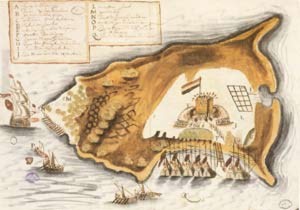Tortuga also called “Association Island”
Tortuga was discovered by Europeans in 1494, during the second voyage of Christopher Columbus into the New World. Columbus’ sailors called it Tortuga (“Turtle”) because its humped shape resembled a turtle.
L’ile de la Tortue, shaped as a sea-tortoise, stands off the northern coast of Hispainiola. It is very mountainous and has dense hardwood forests that grow upon the rocky slopes. The rocks are abundant on the northern part of the island. As a result the population mostly live on the southern coast of the island where the arable land is.
The southern part of the island is divided into four; the first part is called Low Land or Low Country. This is the main part of the southern coast and contains the island’s port. The town is called Cayona, and there live the richest planters of the island. The second part is called the Middle Plantation. Its territory only grows Tobacco well. The third part is named Ringot. These three areas are situated towards the Western end of the island. The fourth area is called the Mountain and is mostly forest.
Tortuga was originally settled by a few Spanish colonists. But in 1625 French and English settlers arrived on the island after initially planning to settle on the island of Hispaniola.
In 1629 the French and English settlers were attacked by the Spanish commanded by Don Fadrique de Toledo. The Spanish expelled the French and English and fortified the island. After most of the Spanish army left for Hispaniola (to drive out French colonists there,) the French returned to retake Tortuga and expanded on the Spanish-built fortifications and in 1630, the French built Fort de Rocher. After1630 the island of Tortuga was divided into French and English colonies which allowed buccaneers, to use the island as a base of operations.
In 1635 the Spanish returned and quickly conquered the English and French colonies, a campaign made easier by disagreements between the French and English colonists. Shortly after this conquest the Spanish decided that the island was too small to be of major importance and they withdrew their troops allowing the return of both French and English Buccaneers. In 1638, the Spanish again sent troops to take the island and to rid it of all French and newly settled Dutch. This time they occupied the island, but were soon expelled by the French and Dutch colonists.
By 1640, the buccaneers of Tortuga were calling themselves the ‘Brethren of the Coast.’ The pirate population was mostly made up of French and English, along with a small number of Dutch. In 1645, in an attempt to bring harmony and control over the island, the acting French governor imported 1,650 prostitutes, hoping to regularize the unruly pirates’ lives. By the year 1670, as the buccaneer era was in decline and many of the men, seeking a new source of trade, turned to log cutting and trading wood from the island. The French authorities realised that if the buccaneers completely vanished the island’s protection from the Spanish would be gone as well. So the government hired the buccaneers and encouraged their activities which has long allowed Tortuga to remain a refuge for the Free Booters.

